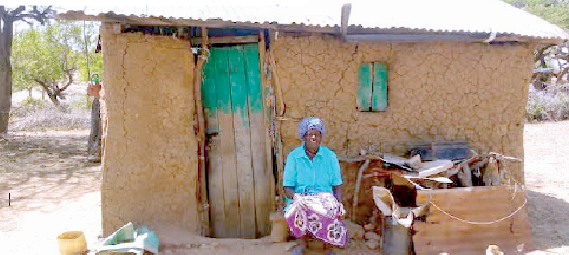My battle and triumph over trickster disease – Kala azar

At 7am, the sun rises over Kongelai village in Rairiwo Ward, West Pokot county.
The soft light seeps through the indigenous trees that surround Mary Alamak’s homestead drawing golden lines on the barren landscape as I arrive for a chat.
Alamak, 48, is busy in her make-shift kitchen (a fire place consisting of three stones) right next to her mud-walled house preparing breakfast for her five children.
Soon, she will be out in the rugged hills, with her last born strapped on her back and a tribe of 12 goats looking for pasture and water 10 kilometers away at Swam River.
Swam River is located at the border of North and West Pokot and serves residents of Kongelai and Kacheliba locations.
Kongelai, where she comes from, has suffered prolonged drought and animals are dying. The drought has been worse this year. Two months ago, she lost eight goats.
“It is difficult to get food and pasture for our animals. The little food we have, we buy from Uganda traders that cross the border to Kacheliba Market on Thursday’s to sell their produce,” she begins.
Alamak is a survivor of a little-known parasitic disease, visceral leishmaniasis (VL), also known as kala-azar disease, which is endemic in the region.
She is not alone. A number of Kongelai residents have suffered from VL-a neglected tropical disease locally known as termes.
Children most affected
Simon Bolo, head of Leishmaniasis Access at the Drugs for Neglected Diseases initiative(DNDi)— a not-for-profit research and development organisation, says an estimated 900,000 to 1.3 million new cases of Leishmaniasis are recorded every year globally.
The Leishmaniasis country profile— 2016 for Kenya published by World Health Organisation (WHO) in August 2020 had only 692 cases and no data about age was available. In 2019 there were 1,463 cases reported.
In Kenya, VL is endemic mainly in arid and semi-arid regions of West Pokot, Baringo, Isiolo, Marsabit, Turkana, Kitui, Garissa and Wajir counties.
Bolo explains that kala-azar is fatal if left untreated and is the second deadliest parasitic killer in the world after malaria. Symptoms, include prolonged fever, enlarged spleen and liver, substantial weight loss and progressive anaemia.
“Leishmaniasis in all its forms affects the poorest people in the community and affected regions are often remote and unstable—with limited resources for treating the disease,” said Bolo.
Alamak recounts her psychological burden with kala-azar, a disease caused by Leishmania parasites that are transmitted by the bite of infected female phlebotomine sandflies.
Her emotional distress started back in 2009, when she fell sick while pregnant.
“I had continuous bouts of fever, headache, constant coughs and belly pains. I used to literally pour water all over my body while sleeping to cool if off. I could not cover myself with a blanket at night,” she narrates sipping her morning tea next to the fire place.
Trekking to hospital
Initially, she thought it was the usual morning sickness as a result of the pregnancy. In March 2010 things became worse.
Her weight fell from 80 kilogrammes to 45 kilogrammes in a matter of weeks. She feared for her life and that of the baby.
“The fever was too much at night, I could not sleep inside the house,” she tells People Daily.
She started sleeping in a nearby thicket, because of the high fever at night, but that too, did not work. She soon resorted to herbal remedies, but nothing changed.
Soon, she started experiencing recurrent nose bleeding.
Her health condition had worsened prompting her to seek treatment at the Kacheliba District Hospital where she was tested for malaria, brucellosis and even HIV.
Surprisingly, all the tests turned out negative. The doctor prescribed antimalarial tablets for two weeks, but nothing changed.
“The doctor thought it was malaria or typhoid. I bought Paludrine (an antimalarial drug) at Sh600, which she took for two weeks,” she narrates.
She went back to Kacheliba District Hospital for further consultation.
The hospital is seven kilometers away from her village. Without any means to reach the Hospital, she would trek for hours on end making numerous stops on the hilly and lowland terrains of the region.
She was two months pregnant.
“I could not climb the hills. Every time I got tired and took time off to rest, my nose bleeding did not stop. It took me seven hours to reach the hospital,” she says while in deep thought.
At the hospital the doctor took her in for an examination and as he touched her stomach to figure out what was ailing her, she happened to mention that her husband too had previously suffered from similar symptoms, which turned out to be Kala-azar. It is that revelation that helped the doctor point out what was really making her sick. She too had Kala-azar.
“My husband had informed me about the long needle that was used to ‘stab’ his abdomen when testing and the excruciating pain associated with the numerous injections administered in the treatment of kala-azar. I couldn’t imagine myself undergoing that horrific experience,” Alamak recalls.
Bolo says one of the key challenges in VL management is late diagnosis. However, through the use of rapid diagnostic technology, the process has now been improved for patients’ experience. “We used to have very invasive diagnostic method for VL confirmation. However, four endemic countries, Kenya included, are already implementing the rapid diagnostic test technology,” Bolo said.
Alternative diagnosis
Luckily, for Alamak’s case, the doctor prescribed alternative testing and treatment.
“After conducting a rapid diagnostic test, the doctor confirmed I had kala-azar,” she says.
She was admitted at the Kala-azar Treatment Ward at Kacheliba District Hospital for treatment.
In April 2010, Alamak was further put on an initial intravenous dosage of Amphotericin B, an antifungal medication used for serious fungal infections and leishmaniasis, under close medical supervision. By end of May the same year, she had gained 20 more kilogrammes.
“I went back and continued with my household activities. Further tests conducted five months later confirmed that I was free of kala-azar,” she says.
“I meet with the patients and teach them about the importance of proper hygiene and sanitation, how to adhere to their medication and emerging issues on Kala-azar, Covid-19 pandemic among others,” said Isaac Nyeris, a community health mobiliser based at Kacheliba District Hospital and deals with all disease outbreaks-mainly Kala-azar.
Nyeris teaches the locals every Tuesday and Thursday on emerging issues about the neglected diseases.
Prolonged drought
Kala-azar epidemics are aggravated by climatic conditions, co-infections, such as HIV, and population displacement, such as large refugee movements during conflicts.
Nyeris says the disease is more prominent during drought seasons between the months of April and August. He explains that the sandflies multiplies and since livestock migrate to look for pasture, the flies bite people, infecting them. “In February 2022, the hospital reported about 70 patients with Kala-azar. In the first week of March, we recorded about 20 patients. This number might go up or reduce, it depends, “he noted.
Kala-azar is endemic in the lowland regions of West Pokot, including Kitelakapel, Serewo, Kalemregai, Kakurun and Naktobar. Many patients come from central Pokot too.
Most of the kala-azar endemic areas in the county have a huge number of anthills and indigenous tree species, such as Sese, Akwaakwa and Tuyuwo that have holes harbouring the sand flies.
Nyeris notes that the Ministry of Health and partners in the Neglected Tropical Diseases (NTDs) space need to create awareness on integrated vector management and control in the endemic areas. He further decries the low supply of drugs to manage kala-azar. “There are times the drug supply goes down here at Kacheliba District Hospital that treats and care for Kala-azar patients for free. Few months ago, the facility depleted its stock and we were advised to seek help at Amudat District in Uganda,” notes Alamak lingering with a scowl on her face.
Nyeris urged the Vector Borne Disease Control Unit at the Ministry of Health need to set up more Kala-azar treatment centres across the county to manage the numbers. “We also urge the Ministry of Health to help us set up more testing and treatment sites across the county for the management of kala-azar to contain the situation” said Nyeris.
Major donor budget cuts, indirect effects of the Covid-19 pandemic are putting tens of thousands of lives of Kala-azar cases across Eastern Africa at risk in countries where the disease is endemic.
Dr Sultani Matendechero, Head of Kenya National Public Health Institute (Kenya CDC) emphasised on the need for African countries to start being self-reliant in order to ensure a sustainable elimination of NTDs.
“We have to think of how we are going to start replacing external funding with progressive funding in order to have sustainable programmes. This will prevent us from going back to zero,” he said at a three-day Global Summit on NTDs organised by the END (Ending Neglected Diseases) Fund recently.
“Kala-azar is a very dangerous disease and it’s not easily recognised. I urge people to go for early diagnosis for those who are still not sure,” Alamak said in ending.











